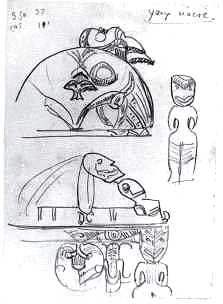|
Gauguin and Maori
art / Bronwen Nicholson ; with contributions by Roger Neich,
Roger Blackley, Jonathan Mane-Wheoki, Richard Wolfe. - Auckland :
Godwit publishing [in ass. with Auckland City art gallery], 1995.
- 80 p. : ill. ; 22 cm.
ISBN 0-908877-69-2
|
En escale forcée à
Auckland (Nouvelle Zélande), Gauguin visite, à
la fin août 1895, The Auckland Art Gallery
et The Auckland Museum. Chacune de ces institutions présente
une collection consacrée à l'art des Maori ; Gauguin
y trouve, pour la première fois, l'occasion d'un contact
direct avec un ensemble diversifié d'objets représentatifs
de la culture polynésienne. Il réagit en artiste
prompt à saisir la nouveauté ; un carnet en témoigne,
où sont notés, d'un coup de crayon souvent elliptique,
formes et motifs ayant retenu son attention.
Ces croquis, et plus généralement
les souvenirs visuels d'Auckland, ont enrichi le répertoire
de formes dont sont nourries les œuvres du second séjour
tahitien, ainsi que la Maison du Jouir d'Atuona dont la
conception d'ensemble et l'ornementation doivent beaucoup aux
Maisons Communes des Maori de Nouvelle Zélande, entre
autres Te Tama-Te-Kapua dont il avait pu voir des photographies.
En contrepoint à cette
analyse précisément documentée, Jonathan
Mane-Wheoki s'interroge : « By what right had this
French bohemian dragged Maori imagery into a primitivist mythology
and iconography of his own imagining ? », tout
en reconnaissant que si la question est pertinente aujourd'hui,
personne n'était en situation de la formuler à
la fin du siècle dernier. L'auteur relève nombre
d'exemples de « détournements »
imputables à Gauguin : « Should Gauguin's
appropriations ever become an issue, it would surely be on the
basis of the incongruity of his placement of Maori imagery within
exotic, tropical pictorial settings painted in sweet, high-key
colour harmonies entirely at odds with the more earthy coloration
of taonga Maori. » La controverse ici
n'est donc pas poussée sur le terrain politique ; a posteriori,
Jonathan Mane-Wheoki reconnaît implicitement à Gauguin
le mérite d'avoir été le premier « passeur »
entre deux mondes que tout opposait avant lui.
|
| SOMMAIRE |
Preface, Christopher Johnstone
Foreword, Richard Brettell
- Gauguin and maori art, Bronwen Nicholson
- The Auckland Art Gallery, Roger Blackley
- The Auckland Museum, Richard Wolfe
- He ao weherua : Gauguin
and taonga maori, Jonathan
Mane-Wheoki
References
Notes
|
|
|
COMPLÉMENT
BIBLIOGRAPHIQUE
- Paul Gauguin, « Noa Noa »
texte établi et annoté par Pierre Petit, gravures
réunies et commentées par Bronwen Nicholson, Paris :
Jean-Jacques Pauvert, 1988
|
|
| mise-à-jour : 10 avril 2013 |
 | « Auckland sketchbook », p. 5
reproduit p. 41 |
| |
|